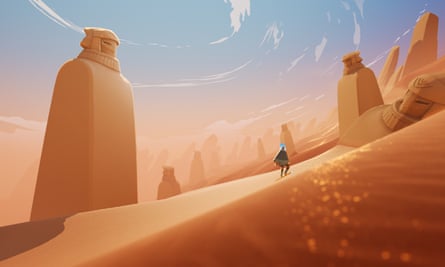There’s a joyous moment in the 2012 game Journey where, in a break from trudging through the desert, your robed character surfs effortlessly down a mountain of shifting sand while Austin Wintory’s award-winning soundtrack rises into an uplifting, triumphant melody. Sword of the Sea feels like that joyous moment has been stretched into an entire game.
Matt Nava, director of Sword of the Sea, says that he set out to create something fresh in the snowboarding/surfing genre, where the sea is made of undulating, ever-moving sand, and your surfboard doubles up as a weapon. Nava was the art director for Journey, but he left thatgamecompany shortly after Journey’s release to co-found Giant Squid, which launched the serene underwater exploration game Abzû in 2016, followed by third-person action adventure The Pathless in 2020. Sword of the Sea mixes elements from all of Nava’s previous games. “I think people definitely are going to feel that connection to Journey,” he says, not least because Austin Wintory is returning to compose the soundtrack, but also because Sword of the Sea tells an emotive story without any dialogue – or as Nava puts it, “creating narrative with colour and music and space”.

There are nods to Abzû in the sense that the aim is to turn the desert into an ocean populated with all kinds of marine life. The influence of The Pathless can be felt, too: for the bow-and-arrow combat in that game, Nava says the studio wanted to make the player feel like a “pro archer”, making it easy to pull off spectacular shots. Similarly, in Sword of the Sea, the studio wants you to feel like a pro hoverboard surfer, able to pull off dramatic flips and tricks without the need to memorise complex button presses.
The look of Sword of the Sea instantly brings to mind Nava’s previous work on Journey, with its vast desert and mysterious ruins. Nava adores ancient architecture, and aimed to develop an architectural style that feels vaguely familiar, but mixes elements from different cultures to create something new and different. Although squeezing in hoverboard-friendly ruins was a challenge. “For this game, a big consideration is: which kinds of architectural forms are a good half pipe?” he says.
Nava says that when the water returns to the desert in Sword of the Sea, “it doesn’t become a flat ocean plain, it stays mountainous” – and thus all the more fun for surfing. He adds that the studio wanted to give people a chance to playfully interact with the denizens of the deep, just like in Abzû, but they also wanted to restrict the action to skimming about on the surface. The solution was unorthodox: make the marine creatures swim in the air. “We’ve kind of just embraced the surrealism in this game,” says Nava.

The 2005 game Shadow of the Colossus has been a big influence on the game’s combat, he says. The player will come across enormous leviathans at certain points, which provide flowing, cinematic encounters where your character remains in constant motion as they attack. But this isn’t a game about slashing through foes: the sword can only be used to attack at certain moments. The main focus is the movement.
The idea of fast-paced, constantly flowing boss fights seems reminiscent of Sonic Frontiers, and Nava says that in the original prototype of Sword of the Sea they actually included many elements seen in Sonic games, such as grind rails and boosters. “We basically decided not to make any of that stuff because it felt so ‘gamey’,” he says. “And it was so interesting to play Sonic Frontiers because we were like, ‘if we had made the opposite decision on every single little mechanic then we would have made this game’. It’s like this Bizarro World, inverted version of what Sword of the Sea could have been.”
Whereas Sonic is all about speed, Sword of the Sea centres on spirituality. The main character is hollow, a wraith in a suit of armour, a vessel to be filled. The environment itself is a character, and the focus is on developing a deep connection between the world and the player, says Nava. It is something that is inspired by his own experiences of scuba diving, snowboarding and surfing, times when he has felt a strong spiritual connection with the environment around him.
“I think it’s really important to everyone to have that connection,” he says. “For me, it’s just really being out there in nature, and seeing the beauty of this incredible world. You can see the patterns within it, but you can’t really understand them all, it’s so massive and magnificent. And I think that we have an opportunity with our games to convey that sense: the medium of games is uniquely equipped to deliver a really spiritual experience to people.”

Comments (…)
Sign in or create your Guardian account to join the discussion